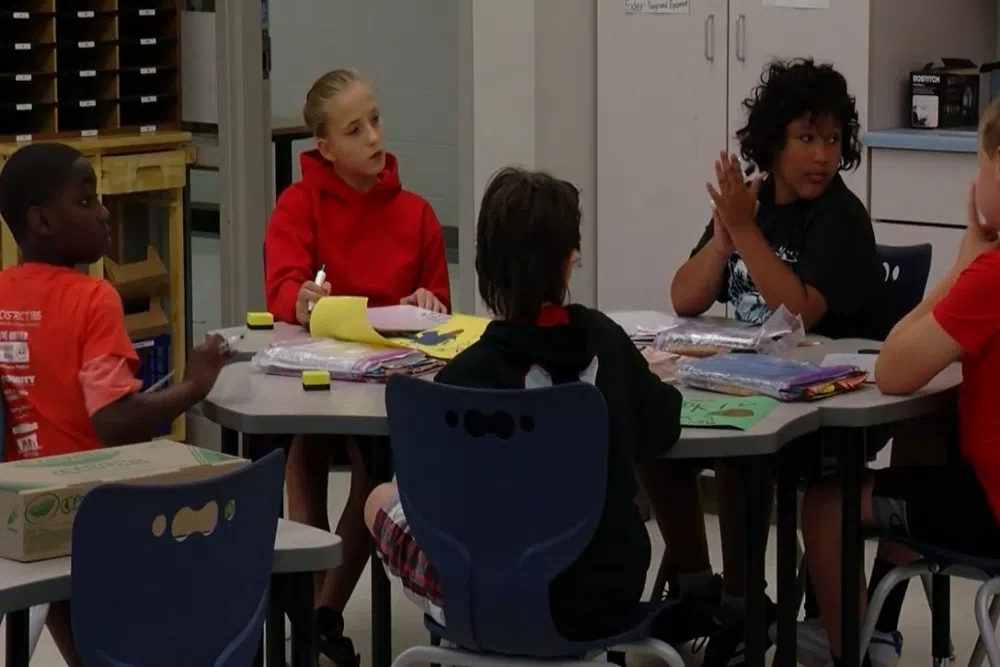SPRINGFIELD, Ill. (Capitol News Illinois) – Education officials from five statewide organizations are pushing for fundamental changes in the way student achievement is measured each year and how schools are held accountable for meeting the state’s academic standards.
In a new report entitled Vision 2030, organizations representing local school boards, superintendents, principals, district business officers, and regional superintendents argue that in the aftermath of the COVID-19 pandemic, the entire landscape of public education has been dramatically altered, presenting new challenges and heightened scrutiny of public schools.
The report is similar to one the same groups released about a decade ago, Vision 20/20, that pushed for reform of the state’s school funding system, eventually leading to the adoption of the Evidence-Based Funding formula that is used today to steer state funding to the neediest school districts.
The new report makes recommendations on several aspects of public education, such as improving schools’ focus on college and career readiness, enhancing student safety and well-being, and attracting and retaining a diverse educator workforce – all subjects that are routinely at the center of most discussions about education policy.
But the groups also argue in the new report that it’s time to take a new look at the whole system of outcomes-based accountability for schools, something that has been a central focus of public education since the 1990s.
They say the current system of grading schools based largely on standardized test scores fails to give an accurate picture of how well students are doing or what schools need to do to improve.
“This might seem counter intuitive, but educators do welcome accountability,” Jason Leahy, executive director of the Illinois Principals Association, said during a media briefing about the report. “But we just want to make sure that the accountability really talks about the comprehensive work that educators do, much more than just test scores.”
State Assessments
In the 1990s, Illinois, along with most other states, began moving to an outcomes-based education model in which teachers, schools, and districts were graded based on how well their students were learning. That was measured by how students performed on standardized tests that were tied to the state’s official learning standards for each subject and grade level.
Such systems became a federal mandate in 2002 with passage of the No Child Left Behind Act – later replaced by the 2015 Every Student Succeeds Act – which required standardized testing as a condition of receiving federal education funding. NCLB also required states to adopt systems of holding schools and districts accountable – through things like focused remedial programs or administrative sanctions – for making continuous improvement toward the goal of having all students meet or exceed the state’s academic standards.
Today in Illinois, students are tested in English language arts and math in grades 3-8 by taking the Illinois Assessment of Readiness. And starting this year, high school students will be tested using the ACT set of exams, which are replacing the SAT exams that have been used in previous years.
Schools also administer the Illinois Science Assessment in grades 5 and 8.
The scores that students earn on those tests are divided into five categories, indicating they either exceeded, met, approached, partially met, or did not meet the state’s standards for proficiency in a particular subject.
Those test scores, in turn, make up a large part of the overall “designations” schools are given each year. The designations are based on test scores and other data for the student body overall and for student subgroups based on race, ethnicity, gender, disabilities, poverty status and other factors.
The top two designations, “exemplary” and “commendable,” are those with the highest overall scores who also have no student subgroups that are significantly underperforming. Exemplary schools are those with overall scores in the top 10% of all schools.
State officials give the bottom three designations to schools that are placed on four-year improvement plans while being given “targeted,” “comprehensive,” or “intensive” supports to address problem areas.
Schools designated for comprehensive or intensive support and oversight represent those with overall scores in the bottom 5% of all schools.
But state and local school officials in Illinois have argued for years that those systems are flawed.
First, they argue, the dividing line between meeting and not meeting state standards – what is often referred to as the “cut score” – is set unreasonably high in Illinois, giving the false impression that Illinois students are significantly less accomplished than their peers in other states.
Gary Tipsord, executive director of the Illinois Association of Regional Superintendents of Schools, said it’s like setting different qualifying times in a track meet.
“If Indiana students are having to run the mile in in seven minutes, and the kids in Illinois are having to run at six, that’s not an equitable comparison. We don’t have parity there,” he said in an interview. “And as it stands, in Illinois today, our cut scores are higher than other states, and then we’re trying to compare what Illinois students are doing to the students in other states, which creates an unfair comparison.”
Officials also argue those designations do not accurately describe how well students are performing academically.
In 2021, for example, only about one-third of high school juniors taking the SAT met or exceeded state standards in English language arts, and slightly fewer did so in math. And yet, after those same students graduated the following year, nearly two-thirds enrolled in college within 12 months of graduation.
The Vision 2030 report also questions the validity of the performance designation for schools, noting the categories are based largely on how schools compare with each other, rather than how they measure up to an objective standard.
“Inevitably, you’re going to have a top 10%. You’re going to have a bottom 5%. Inevitably, you’re going to have that in the way it is structured currently,” Tipsord said. “What you don’t then get is a good system of communicating to communities around the state of Illinois about how their districts are actually performing. … Those designations don’t necessarily inform how your school districts are performing relative to grade-level equivalency, or relative to growth and improvement.”
Recommendations
The Vision 2030 report calls for making several changes to the state’s testing system, including recalibrating the benchmarks that define “proficiency” in a given subject. Those benchmarks, they argue, should be aligned to a national standard such as the one used for the National Assessment of Educational Progress, or NAEP exam, which shows Illinois students rank about average nationally across most subjects and grade levels.
The report also recommends the Illinois State Board of Education work with its State Assessment Review Committee to develop a new test that not only measures students’ proficiency at a particular grade level but also tracks their growth over time.
In addition, the report recommends releasing unofficial test results earlier, “in near real time,” so teachers can use the information to adapt their teaching methods. Currently, tests are given in the spring, but results are not reported until the following fall, long after instruction for the next set of students is already underway.
The authors also recommend overhauling the state’s system of ranking schools for accountability purposes so schools are measured against a fixed, objective standard, rather than comparing them to one another.
It also recommends using a scoring system that takes into account both the proficiency rate among students as well as the “growth” rate for students who are below proficiency.
“Proficient students should meet or exceed expectations, while students below proficiency should accelerate rates of growth to achieve proficiency over time,” the report states. “Therefore, within the broader accountability scoring system, student growth should be given more weight for students below proficiency and less weight for proficient students.”
(Reporting by Peter Hancock, Capitol News Illinois)
Capitol News Illinois is a nonprofit, nonpartisan news service that distributes state government coverage to hundreds of news outlets statewide. It is funded primarily by the Illinois Press Foundation and the Robert R. McCormick Foundation.







Comments